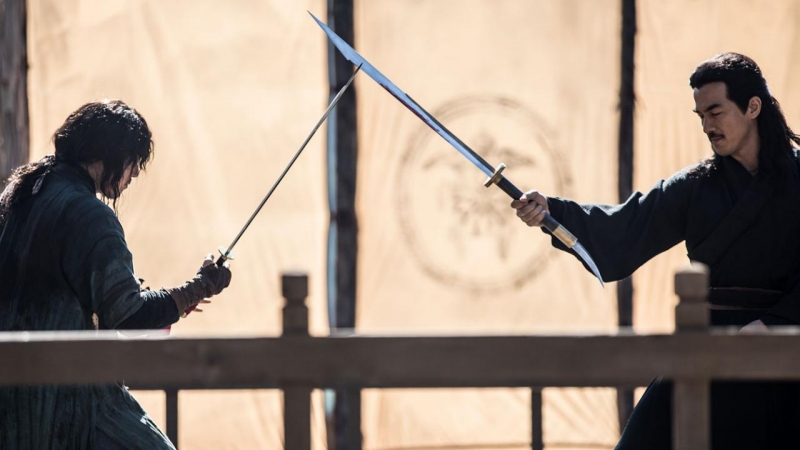Gene Ching is the author of Shaolin Trips and served as the Publisher of Kung Fu TaiChi, a North American newsstand magazine, for 20 years. He is a 32ndgeneration layman disciple of the Shaolin Temple in Henan, China, a certified Provost at Arms in Fencing, and served as a weapons expert for the TV show Manat Arms: Art of War.
Movies are powerful mediums for introducing martial arts to the general public. Films attract a wide audience by design, and nothing beats the worldwide appeal of a good action movie. Despite being mostly fictional, a good martial arts movie can spotlight the specialties of the filmmaker’s national art, as well as share the unique cultural diversity of their country. Intrinsic ethnic elements within the story such as costume, mythology, and propounded philosophies are shown, especially within period films. While these cultural snapshots appear between fight scenes, they still help to promote cross cultural exchange and mutual understanding.
Granted martial arts films often lack substance. Most are B-grade movies full of hackneyed cliches and gratuitous violence. Nevertheless, some exceptional films were complete gamechangers for catching the public eye, films like Enter the Dragon (1973), The Karate Kid (1984), and Crouching Tiger, Hidden Dragon (2000). Moreover, the Chinese Kung Fu and Japanese Samurai film genres have popularized martial arts worldwide for decades. Now, other Asian nations are producing films showcasing their own national arts including India, Indonesia, Malaysia, and Thailand. Korea has emerged as global filmmaking powerhouse as demonstrated by the historic 2019 Academy Award wins of Gong Joon-ho’s groundbreaking Parasite (Schindel, 2020).
Korean cinema has become increasingly popular in the West, so much so that Netflix is investing $500 million on Korean content for 2021 (Brzeski, 2021). The recent Korean film The Swordsman is a prime example of how a good movie can be a gateway for cultural understanding. Originally released in South Korea on September 23rd, 2020 after a week delay due to the pandemic, The Swordsman was distributed across several other Asian nations over the following month and has worked its way to North America in 2021.

Unsheathing the Sword
The Swordsman is set during the Joseon period (1290-1897) when Korea was oppressed by China’s Qing Dynasty (1636-1912). The characters are complex and emotionally engaging, more so than in most martial arts movies. Jang Hyuk plays Tae-yul, a master swordsman who is going blind. He lives as a mountain recluse with his daughter Tae-ok (Kim Hyun-soo). Jang is a genuine Taekwondo and Jeet Kune Do practitioner, so he handles the fight scenes with panache. Man-sik Jeong plays Min Seung-ho, a senior rival swordsman. He's a good counterpoint to Tae-yul as a more reserved and seasoned sword master trying to do right under a corrupt government. Most notable is the villain - a smarmy Chinese overlord Gurutai played by real-life Indonesian Judo champion Joe Taslim. Taslim’s breakout was in the Indonesian film, The Raid (2010). Since then, he’s appeared in Hollywood blockbusters including Fast and Furious 6 (2013) and Star Trek Beyond (2016) as well as in the Bruce Lee-inspired TV show Warrior (2019-2020). He has a role in the upcoming reboot of Mortal Kombat, coming this April.
The Swordsman recounts many time-honored martial arts tropes. It's a rich tale of intertwining intrigues, oppression, villainy, revenge and honor, a battle to be the best swordsman in a crumbling, selfish world that has lost sight of the way of the warrior. Tae-yul, Min Seung-ho, and Gurutai duel each other for different personal reasons, but ultimately their fates are decided with steel and blood.
The fight choreography explodes whenever blades are drawn. It's swirling cinematograph and complicated melee exchanges, including a beautifully shot 43-second single take when Tae-yul cuts down a dozen riflemen. For discerning martial artists, most cinematic swordplay is merely flashy swashbuckling with no sense of the staccato rhythm of actual sword fighting. The Swordsman stages some more authentic sword fights depicting feints and breaks in tempo, albeit with dramatic liberties. The action scenes are captivating as tension escalates towards the finale showdown, just like a good martial arts movie should.
For westerners, the sword style appears somewhere between Japanese Chanbara and Chinese Wuxia because these genres have precedence. However, Korea, like any country that develops metallurgy, has native sword traditions. Although Taekwondo is one of the world’s most popular martial arts, traditional Korean swordsmanship remains relatively obscure outside of Korea. Hopefully, The Swordsman will help stimulate efforts to revitalize Korean swordplay globally.
Beyond thrilling sword fights, The Swordsman also offers a peek at Joseon culture. Philosophically, it exemplifies Asian ideals of filial piety, loyalty, and perseverance. It also showcases traditional fashion like those extraordinary Joseon period hats. For most westerners, The Swordsman is their first exposure to the rich legacy of Joseon headwear. This is steppingstone towards cross cultural understanding. The more different cultures understand about each other, the greater the potential for world peace, and it can all begin with a good martial arts movie.
References
-The Swordsman (2020) Directed by Choi Jae-hoon [Film]. South Korea: Opus Pictures.
Brzeski, P. (2021) Netflix to Spend Nearly $500 Million on Korean Content This Year [Online]. Available at: https://www.hollywoodreporter.com/news/netflix-to-spend-nearly-500-million-on-korean-content-this-year (Accessed: 26 February 2021)
-Schindel, Dan. (2020) Parasite’s Historic Wins at the 92nd Academy Awards [Online]. Available at: https://hyperallergic.com/541820/bonghive/ (Accessed: 26 February 2021)
-PHOTOS: THE SWORDSMAN-Well Go USA-Korean action films (2020) The Swordsman [online]. Available at: http://www.wellgousa.com/films/the-swordsman (Accessed: 26 February 2021)


















